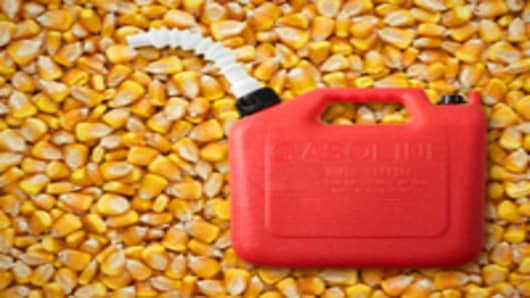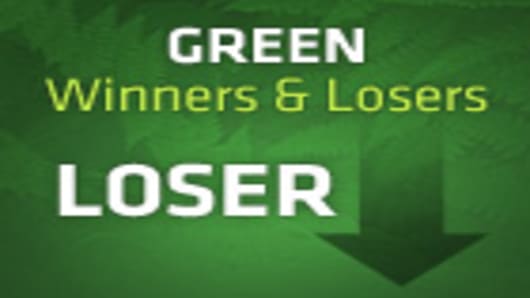The ethanol industry has had a profitable year despite the jump in corn prices, but the industry faces a slew of headwinds, including overcapacity and political pressure to cut generous incentives.
“We have a lot of customers who are ethanol investors and plants have been very diligent paying down debt in 2011,” says Jason Ward, director of grain and energy for Northstar Commodity. “Kudos to them, but there is definitely some rough waters ahead for the ethanol sector.”
One concern is the December expiration of the 45-cent-per-gallon tax creditthe industry gets for blending ethanolinto gasoline, at a cost to taxpayers of about $6 billion a year. A 54-cent-per-gallon excise tax on imported ethanolis also set to expire at the end of the year.
But Ward and other analysts say the industry may be ready for elimination of these tax subsidies.
“This will make ethanol stand on its own, something I believe the industry is prepared to do,” he says. “It is my belief that blenders will continue to blend ethanol at the same volume because it simply makes their gasoline cheaper and they need an additive.”
Another proposal, more worrisome to the industry, would reduce the amount of ethanol required by the Renewable Fuel Standard when corn supplies are tight. The purpose of the proposed legislation is to ensure supplies are amply available for feed corn.
The tax credits help determine what the price of ethanol can be relative to gasoline, but the Renewable Fuel Standard “means ethanol will either be or will not be demanded,” says Elizabeth Collins, a Morningstar analyst.
In a recent report, JPMorgan analysts Ann Duignan and Michael Shlisky say the bill, if it passes, could lead to a significant drop in corn prices, particularly in the months leading up to November, when the government would assess the “stocks-to-use” ratio of corn supplies. A stocks-to-use ratio is a measure of a supply-and-demand relationship, which in this case would be between corn stocks and their use for feed, fuel, and exports, among other things.
Under the legislation, which was introduced by Rep. Bob Goodlatte, R-Va., and Jim Costa, D-Calif., in the U.S. House of Representatives, a stocks-to-use ratio of below 10 percent would allow the U.S. Department of Agriculture to lower the Renewable Fuel Standard (RFS) for ethanol in the following year on a sliding scale by as much as 50 percent.
The bill is not expected to pass at this late a date this year, in part because a Senate version hasn’t been introduced, but it remains a “headline risk” to the industry, and could mean the potential for the RFS to be modified in some way “within the next few years,” according to a report by Mark McMinimy, a research analyst at MFGlobal.
Aside from political considerations, the ethanol industry’s fortunes swing on the basis of corn and gasoline prices. It’s these factors, according to the USDA, that can determine how much ethanol is exported and how much is blended into gasoline above the amount mandated by the Renewable Fuel Standard.
When gas prices are high, ethanol is in more demand for such “discretionary blending,” the USDA says.
Exports have provided a bright spot for the industry since last year as U.S. corn-based ethanol has become far less costly than Brazilian ethanol, which is mostly made from sugarcane.
According to the USDA, the U.S. had already exported more ethanol in the first five months of 2011 than it had in all of 2010, which was also a big year for exports. In 2010, the industry generated $825 million in revenues from exports; through the end of May this year, the industry generated $1 billion in export revenues, the USDA said in a July 20 International Agricultural Trade Report.
The biggest ethanol producers in the market are Archer Daniels Midland and, more recently, oil refiners, including Valero and Sunoco. But there are several smaller companies across the country, including Pacific Ethanol in Sacramento and BioFuel Energy in Denver.
Pacific Ethanol however, is under threat of having its stock delisted from the Nasdaq because it’s trading under $1 a share. The stock is under pressure from the potential removal of tax subsidies, according to Ian Gilson, an analyst at Zacks Investment Research. Gilson’s view is the subsidy will be reduced, but not eliminated, leading him to expect Pacific Ethanol’s share to rise to $3.
While high levels of production from producers both big and small are contributing to lower prices for ethanol compared with other countries, Morningstar’s Collins remains concerned with overcapacity in the industry, particularly when there are few barriers to entry for new competitors.
That’s particularly problematic because the ethanol industry in general isn’t attractive, she says.
“Ethanol plants are price takers on both sides—they have to pay the price of corn, and accept the price of ethanol,” Collins says. “Because of that the only time they can do well is when spread between ethanol and corn is wide. That doesn’t happen often.”



